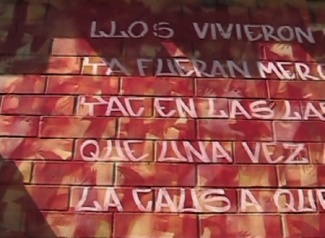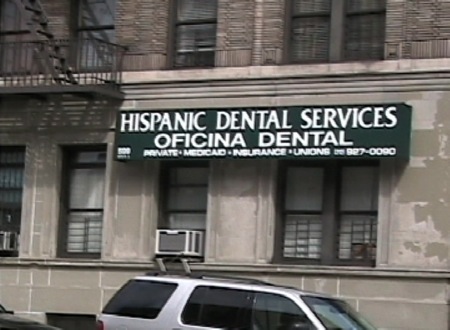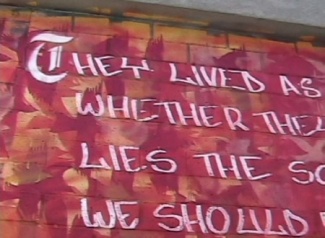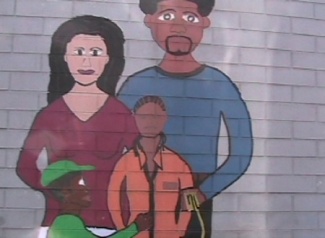Washington Heights: Here v. There
From Decoding New York
| Introduction |
| Washington Heights |
| * Evolution |
| * Here v. There |
| * What's Real |
| * Economy |
| Rego Park |
| * Evolution |
| * Here v. There |
| * Economy |
| Comparison |
| * Photo Gallery |
| * Sources
|
The greatest over-arching theme for Washington Heights under the subject of "Here vs. There," is the issue of identity, whether that be the creation of a new "American" identity, the preservation of a past identity, or the formation of a new identity altogether which becomes an amalgam of two cultures.
For example, the article "Dominican Americans in Washington Heights" reveals through its interviews with local, immigrant residents that the most difficult hardship faced by immigrants today is juggling the divide between two cultures. The article's first subject named Yolanda reflected upon the difficuties of being in school when you are constantly moving between two cultures, "And then by the time I would come back, I would be far behind in my reading and English. So it was like trying to catch up in both places (Dicker 721).
According to Duany’s field research in Washington Heights, many Dominicans journey to Washington Heights temporarily in search of economic opportunity. For example, one of his interview subjects reflects, “Here is where they can make and save money, advance economically, help their families, and secure a better future for their children.’ There is ‘‘‘my country,’’ a place where one belongs, enjoys, rests, lives peacefully and happily’ (Duany 39).
When increasing numbers of Hispanic immigrants started arriving in the 1960's and 70s a need developed for supportive community organizations that would help immigrants adapt to problems created by the gap between their country's language and culture, and the new language and culture of the United States. These institutions focused on helping immigrants maintain their previous cultural ties and identites, while simultaneously teaching them ways to integrate themsleves more successfully into our economy, and society. For example, in the Dominican population Sainz notes that these organizations helped participants build connections with other Spanish speaking small business operators and workers who could lead them to service and delivery roles in the area (Sainz 25).
Aside from the economic advantages of immigrants establishing ties with other United State's citizens from their homeland, there could also be a reassuring mental advantage to being around others who have the same basic framework for reality. For example, one of researcher Jorge Duany's Dominican interviewees from Washington Heights described how race ideas differ here, because in the Dominican Republic the boundaries between white and black tended to be more blurred, with mixed racial catergories playing an important role. For example, the Dominican woman interviewed used to think of herself as (India Clara) meaning a light Indian, but observed that when she arrived in the United States people often lumped her into the broader U.S. racial category of Hispanic (Duany 147).
Politics in Washington Heights reflects a similar intermingling between past and present immigrant countries. United States politicians like President George Bush, Governor Pataki, and Mayor Bloomberg will make trips to Mexico, Puerto Rico, and the Dominican Republic to build their support network of trans-national voters, while Mexican officials will often make trips to heavily populated hispanic immigrant areas in the United States like New York, Texas, Caifornia, or Arizona (Criado 12-13).
According to Susan Dicker, even the act of attaining United States citizenship in itself can be seen as an act beneficial on two accounts for many Hispanic immigrants, “citizenship guarantees membership rights in these immigrant’s homeland along with the assurance that they can return after visiting the native homeland.” He notes that this flexibility was especially important when stricter immigration laws were passed in 1996 (Dicker 714-715).
A final notable factor in observing the differences between “here and there” for new immigrants settling in Washington Heights is the role of the mainstream media. In a final interview out of the series conducted by Jorge Duany, one interviewee reported, “When I turn on the television, I don’t find anything that represents me, as a Dominican . . . I’m tired of hearing, you know, it’s the highest kids’ drop-out. And if you speak to those kids, if you speak to, you know, any young Dominican, they’re very intellectual, but in their own way and manner that is not being recognized. And I want to create a medium so that, um, we can identify ourselves as, yes, we are intellectual Dominicans and no, we don’t all play baseball” (Duany 173).
I feel, however, from my observations of the area that the Washington Heights community seems to have developed its own internal structure and media outside of the boundaries of our national, mainstream media. For example, walking along the streets I would hear radio blasting Spanish speaking music stations playing up-tempo reggaeton. In addition, modern day Washington Heights streets are covered with promotional flyers for popular Hispanic reggaeton artists who seem to be highly successful in this community because of all of the radio play and promotion, but who aren’t played on our national music channels like MTV. Finally, every major billboard, advertisement, or sign in the area was printed solely in Spanish. For example, even a gigantic Jack Daniel’s Whiskey billboard had been transformed into a Spanish-oriented advertisement.
It seems as though the area is such a haven for the Dominican population, that new immigrants have a much easier time acclimating to life in Washington Heights without altering old traditions in comparison to the struggle it would take a Hispanic newcomer to adapt to New York City life in an area without the support of others who knew of their culture. In correspondence with Duany’s interview subject’s observations about the lack of ethnic media, it seems that the more the newer generation of immigrants start branching out of their ethnic enclaves into other diverse areas of the city, the more they question who they are as a person, when caught between two major cultures.

This section on Washington Heights and Rego Park developed by Irina Mullokandova, Karina Fatova, Quinn Marston.


